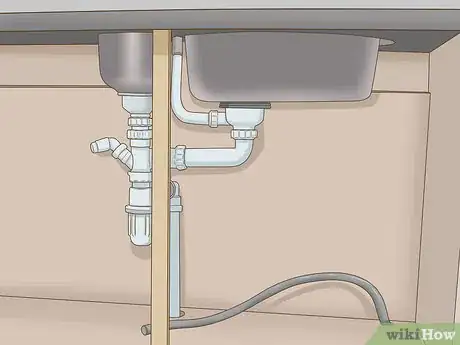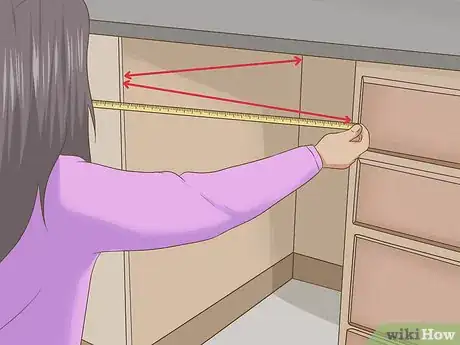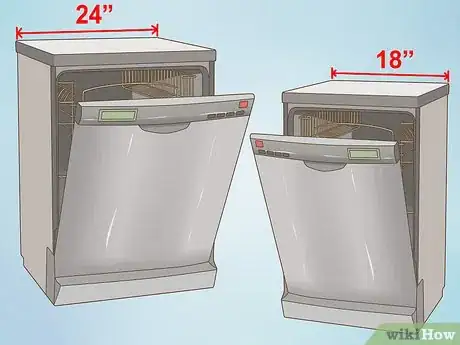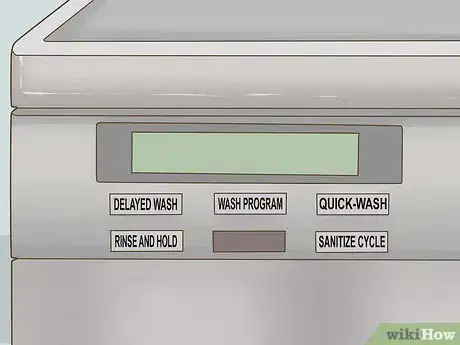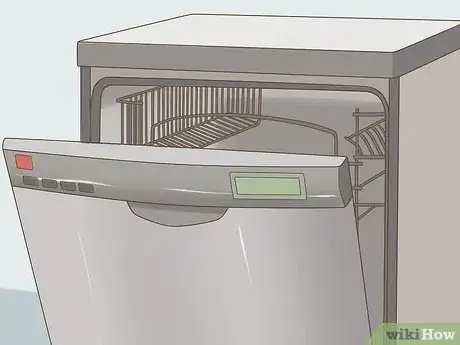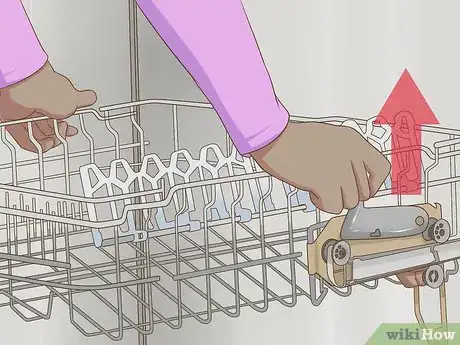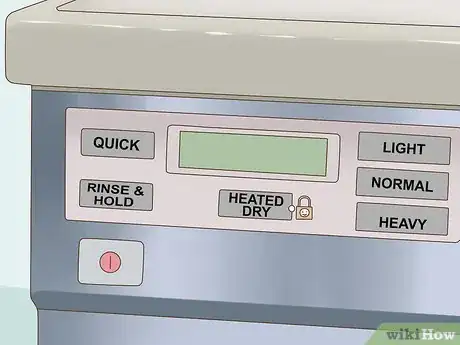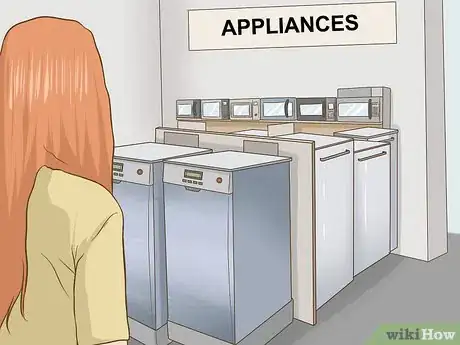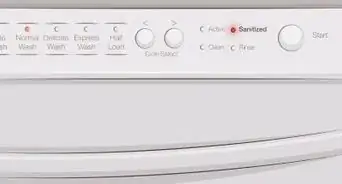This article was co-authored by Gevorg Grigorian. Gevorg Grigorian is an Appliance Repair Specialist and the Owner of G and R Appliance Repair in Los Angeles, California. With over 12 years of experience, Gevorg specializes in residential and commercial appliance repairs as well as heating, ventilation, and air conditioning (HVAC) services. Gevorg holds a BS in Business Administration and Management from California State University-Northridge.
There are 12 references cited in this article, which can be found at the bottom of the page.
This article has been viewed 56,410 times.
Buying a dishwasher can be a huge help when it comes to cleaning dirty dishes. Hand washing is the least efficient way of doing dishes because it wastes a lot of water, so a dishwasher is a great investment for you and the environment. Dishwashers come in several types, sizes, and with many different options for details. Choose a dishwasher that's right for you by inspecting your home, researching dishwashers, and finally, buying a dishwasher.[1]
Steps
Inspecting Your Home
-
1Check to see if your kitchen is dishwasher ready. Look at all of the water fixtures to make sure you are able to add in a dishwasher. Most homes should be dishwasher ready with only an installation needed, which is usually done by the company the dishwasher is bought from. Old homes, however, may need some electrical work done to comply with new rules for new dishwashers.[2]
- Dishwashers now must be on their own dedicated circuit.
- A shut-off needs to be within four feet of the dishwasher.
- A GFCI breaker (protection from moisture and sparking) needs to be on the circuit breaker panel.
-
2Get a portable washer if there is no hook up. If there is no dishwasher hook up in your apartment, choose a portable dishwasher that can be hooked up to kitchen faucet. Once you are done using it, you can store it away in a closet or another area of the home. You can also choose to buy a small, countertop dishwasher, though it will provide less space for dishes.[3]
- Brands such as Kenmore, SPT, Whirlpool, and Danby offer portable dishwashers.
- SPT also offers countertop dishwashers.
Advertisement -
3Measure the space intended for dishwasher. Dishwashers come in multiple sizes. You will need to pick out one that is appropriate for the size of your home or apartment. Take a tape measurer and measure the depth and width of the area you plan to install a dishwasher into. Write down the measurements, take them to a home improvement store, and ask which dishwasher will work for those measurements.[4]
- You can also look through online catalogs to see which dishwasher will work with your measurements.
-
4Decide between integrated or freestanding. Freestanding dishwashers are more common than integrated dishwashers. Freestanding dishwashers are more common because they can fit into any kitchen that has enough space for them. Integrated dishwashers are designed to be incorporated into built-in kitchens. Fully integrated dishwashers are hidden behind a cabinet door, and semi-integrated dishwashers are mostly covered, except for the control panel.[5]
- Freestanding dishwashers are a great choice because you have the option of taking them with you when you move.
- Integrated dishwashers are a good choice if you want the look of a streamlined kitchen.
Researching Dishwashers
-
1Choose between compact and standard. Compact dishwashers are good for smaller spaces. They are typically 18 inches, which leaves extra room for storage. A standard dishwasher is typically 24 inches, and it is ideal for homes with families.[6]
- A compact dishwasher is a better choice if you live alone, or with one partner or roommate.
- A standard dishwasher is ideal if you or someone else will be cooking for a family of three people or more almost every night.
-
2Make sure it has all of the cycles you want. Modern dishwashers typically have more cycles rather other wash and dry. Think about what needs you will have when using the dishwasher, and what type of dishes you will be putting into the dishwasher. Look for dishwashers that meet your needs. A good dishwasher should have a delayed wash, rinse and hold, wash program, quick-wash, and sanitize cycle.
- A delayed wash cycle allows you to set a start time anywhere between one hour and twenty-four hours ahead of time.
- A rinse and hold cycle will rinse food off of a partial load of dishes to remove bacteria and bad smells without using detergent.
- A wash program allows you to choose a custom setting for things like fragile dishes and oven racks.
- A sanitize setting will kill 99.9% of bacteria.
-
3Consider stainless steel for the tub.[7] There are several options for materials for the interior tub of the dishwasher. Plastic tubs are common and found most often in affordable dishwashers. A gray or slate color is another option, and it is good at hiding stains. Stainless steel is a great choice because it resists stains and odors and transfers heat better than other materials, which makes for a faster dry.[8]
-
4Look for adjustable upper racks. Adjustable racks allow you to put together your washer in a way that best fits your needs. This would come in handy when you are washing particularly large items. Look for a height-adjustable rack with two quick-release clips. This allows you to move the rack even if there are dishes in it. A roller rack is another option, but you can only move it when the rack is empty.[11]
- Make sure to take a good look at the inside of the dishwasher before purchasing to see what type of racks are used.
-
5Get a quiet model. A noise is often a factor considered when buying a dishwasher. A loud dishwasher can be annoying in a kitchen where conversation is taking place. Check the decibel level if you are concerned about noise. A decibel level of 45 or under will be almost silent. A decibel level of 50 is equal to the volume of a normal conversation. 44 decibels is the ideal level.
- You can also add extra insulation around the washing tub, door, toe panel, and access controls to reduce noise.[12]
-
6Think about the details. A basic dishwasher may be okay with you, but you should still consider what details you would like to have before purchasing. Details such as a child-safety lock, anti-flood protection, sensor wash, and detergent sensor may come in handy. Dishwashers that feature most or all of these details will likely be more expensive than your average dishwasher, however.[13]
- Anti-flood detection has two main settings. A float switch detects when water is at the bottom of the machine and stops it from filling further into the tub. An aqua-stop prevents flooding if the hose spills or leaks.
- The sensor wash detail determines how dirty the water is and adjusts the temperature and length of wash depending on that reading.
- A detergent sensor can prevent you from washing with too much detergent. The sensor releases as much detergent is needed for the wash.
Buying a Dishwasher
-
1Choose the right dishwasher. You only need a dishwasher that has the capabilities you desire and that is within your price range. Different dishwashers have different features, so choose wisely, and make sure you don't spend your life's savings on a fancy dishwasher. A lot of extra sensors and details are great to have, but they are not necessary if you are on a budget. All you really need are places to put in your silverware, glasses, plates, and bowls. Be reasonable.[14]
- A good price for a new dishwasher is around 800 to 900 dollars.
-
2Check several appliance stores for brands and prices. Don’t buy from the first place you look at dishwashers. Look at websites like Reviewed.com and Consumer Reports to see which models are best. Prices may vary depending on the store, and some stores may be having sales when other are not. Some different stores that sell dishwashers could be Home Depot, Lowe's, or even eBay. [15]
- Make sure that if you are ordering one, check to make sure everything works, such as the sliding rack.
-
3Buy during the right time of year. Certain times of year are better for buying dishwashers. For example, dishwashers will often go on sale around the holidays and when new models are being unveiled. Any holiday weekend, September and October, January, and the end of the month are good times to look for a dishwasher.[16]
- September and October is a good time to look for a dishwasher because manufacturers unveil the new models during this time, so older models will often go on sale.
- The selection may be limited in January, but all of the remaining models from the previous year will often be discounted even more than they were during the holidays.
- Employees will often have a quota they have to fill by the end of the month, so the end of the month is a good time to negotiate price.
Expert Q&A
Did you know you can get expert answers for this article?
Unlock expert answers by supporting wikiHow
-
QuestionShould I get a dishwasher with a plastic tub or a stainless steel tub?
 Gevorg GrigorianGevorg Grigorian is an Appliance Repair Specialist and the Owner of G and R Appliance Repair in Los Angeles, California. With over 12 years of experience, Gevorg specializes in residential and commercial appliance repairs as well as heating, ventilation, and air conditioning (HVAC) services. Gevorg holds a BS in Business Administration and Management from California State University-Northridge.
Gevorg GrigorianGevorg Grigorian is an Appliance Repair Specialist and the Owner of G and R Appliance Repair in Los Angeles, California. With over 12 years of experience, Gevorg specializes in residential and commercial appliance repairs as well as heating, ventilation, and air conditioning (HVAC) services. Gevorg holds a BS in Business Administration and Management from California State University-Northridge.
Appliance Repair Expert
Warnings
- Try to buy only from verified retailers.⧼thumbs_response⧽
- Black Friday is a good time to look for a new dishwasher, but beware of crowds.⧼thumbs_response⧽
References
- ↑ http://dishwashers.reviewed.com/best-right-now/best-portable-dishwashers
- ↑ https://rothmanshore.com/2014/05/11/replacing-your-dishwasher-get-ready-for-some-hefty-electrical-rewiring/
- ↑ http://dishwashers.reviewed.com/best-right-now/best-portable-dishwashers
- ↑ http://www.bhg.com/kitchen/appliances/selecting-a-dishwasher/
- ↑ http://www.which.co.uk/reviews/dishwashers/article/how-to-buy-the-best-dishwasher
- ↑ http://thesweethome.com/reviews/the-best-dishwasher/
- ↑ Gevorg Grigorian. Appliance Repair Expert. Expert Interview. 30 July 2020.
- ↑ Gevorg Grigorian. Appliance Repair Expert. Expert Interview. 30 July 2020.
- ↑ Gevorg Grigorian. Appliance Repair Expert. Expert Interview. 30 July 2020.
- ↑ Gevorg Grigorian. Appliance Repair Expert. Expert Interview. 30 July 2020.
- ↑ http://www.which.co.uk/reviews/dishwashers/article/how-to-buy-the-best-dishwasher
- ↑ http://www.bhg.com/kitchen/appliances/selecting-a-dishwasher/#page=1
- ↑ http://www.which.co.uk/reviews/dishwashers/article/how-to-buy-the-best-dishwasher
- ↑ http://thesweethome.com/reviews/the-best-dishwasher/
- ↑ http://thesweethome.com/reviews/the-best-dishwasher/
- ↑ http://www.moneycrashers.com/best-time-of-year-buy-large-appliances/
- ↑ http://www.which.co.uk/reviews/dishwashers/article/how-to-buy-the-best-dishwasher
- ↑ Gevorg Grigorian. Appliance Repair Expert. Expert Interview. 30 July 2020.
About This Article
To choose a dishwasher, first measure the depth and width of the area you want to install the dishwasher in since dishwashers come in multiple sizes. Then, once you know what size dishwasher you need, start shopping for ones that have the features you're interested in. Generally, you'll want to get a dishwasher that has at least a delayed wash cycle, a rinse and hold cycle, a wash program, a quick-wash, and a sanitize cycle. Also, look for a dishwasher with a decibel level of 45 or under, which will be almost silent when it's running. To learn how to shop and compare dishwashers before buying one, scroll down!
